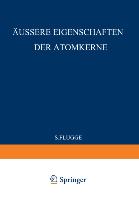- Start
- External Properties of Atomic Nuclei / Äussere Eigenschaften der Atomkerne
External Properties of Atomic Nuclei / Äussere Eigenschaften der Atomkerne
Angebote / Angebote:
39 2 2 Here B = hJ8:!t Ib and A = hJ8:!t Ia where Ia and Ib are the moments of inertia parallel and perpendicular respectively to the symmetry axis. ~ V I(J + 1) is 2n the total angular momentum of the molecule and K ~ its projection on the 2n symmetry axis. If the molecule possesses a permanent electric dipole moment it can absorb a quantum of microwave energy hv and make a transition to a higher rotational' state governed by the selection rules L1 I = + 1, L1 K = O. The pure rotational absorption frequency is then given by v=2BI (1. 2) where I is the angular momentum quantum number for the upper state of the transition. If an isotopic substitution is made for an atom lying along the sym metry axis of the molecule, thus changing its moment of inertia and hence its B value, the rotational absorption frequency will shift. The program of mass determination from microwave spectra is to correlate this frequency shift with the change in mass of the substituted isotope. These shifts can range from a few Mc to several thousands of Mc for a change of one mass unit, being larger generally for the lighter atoms. Typical isotopic shifts in the middle mass region (A =60 to 130) are 100 Mc per mass unit. As mentioned above, frequency shifts in the 24000 Mc region can be measured to at least an accuracy of 0.
Folgt in ca. 5 Arbeitstagen
